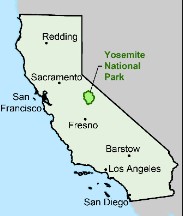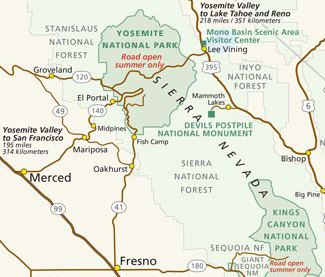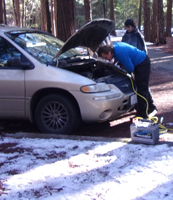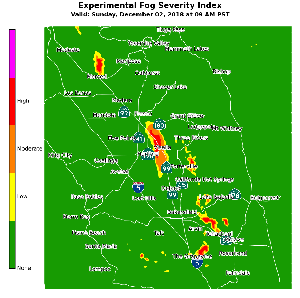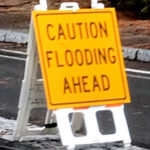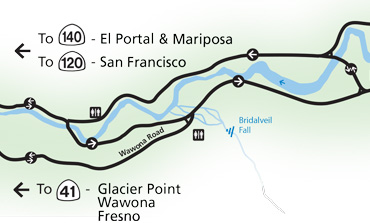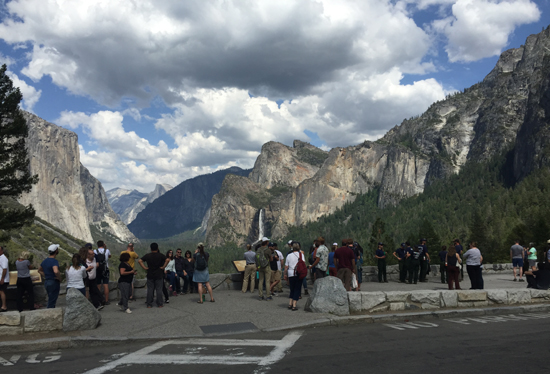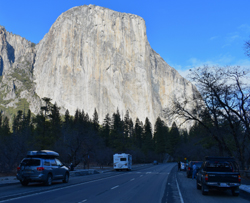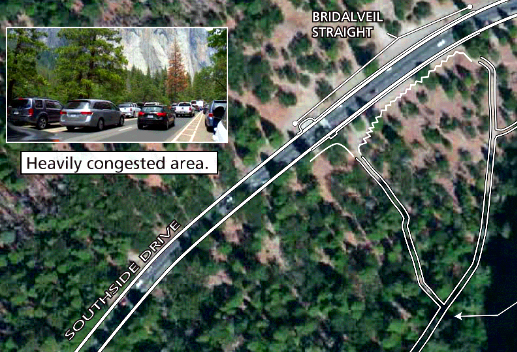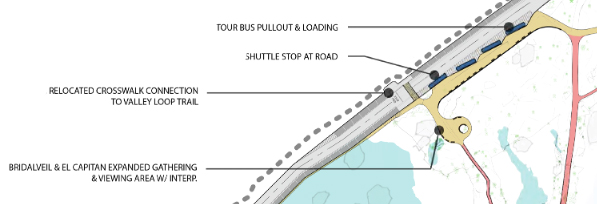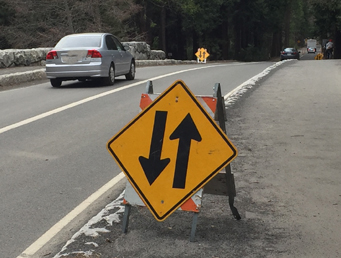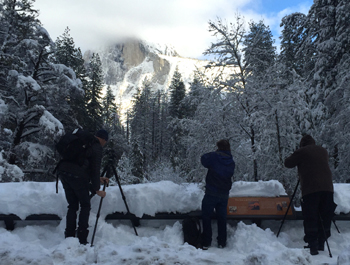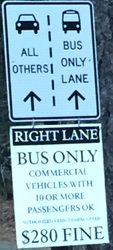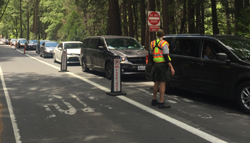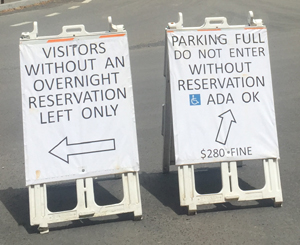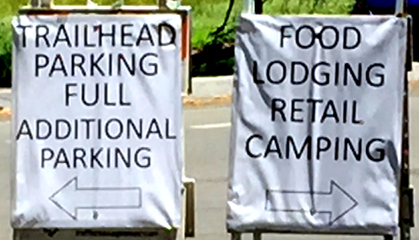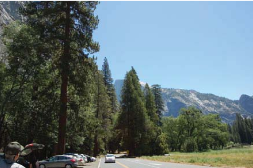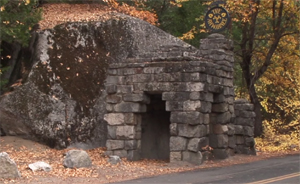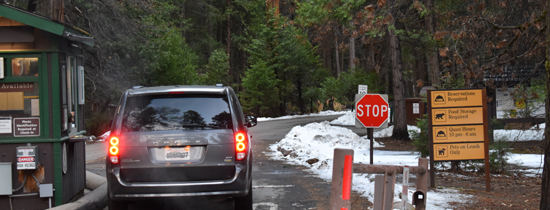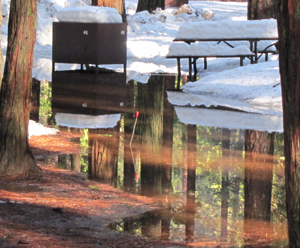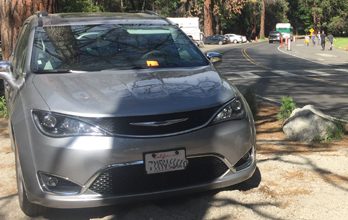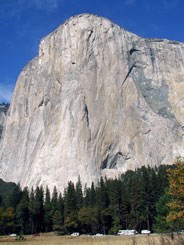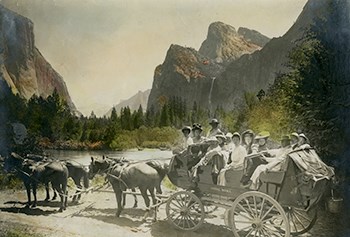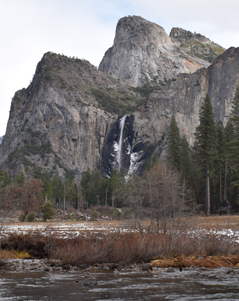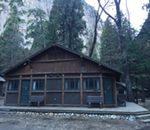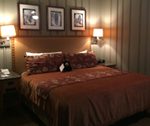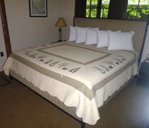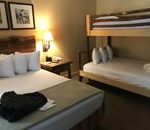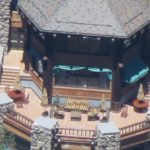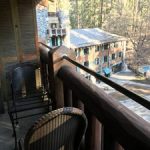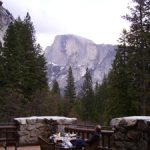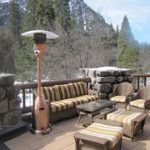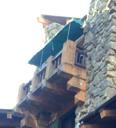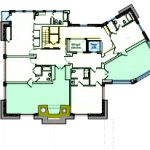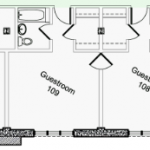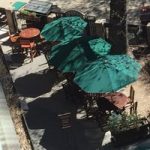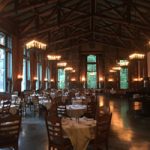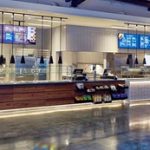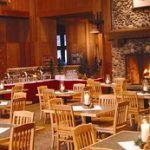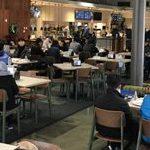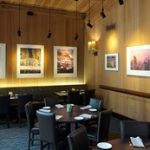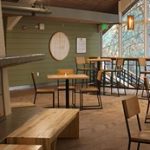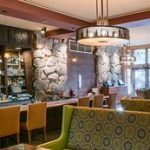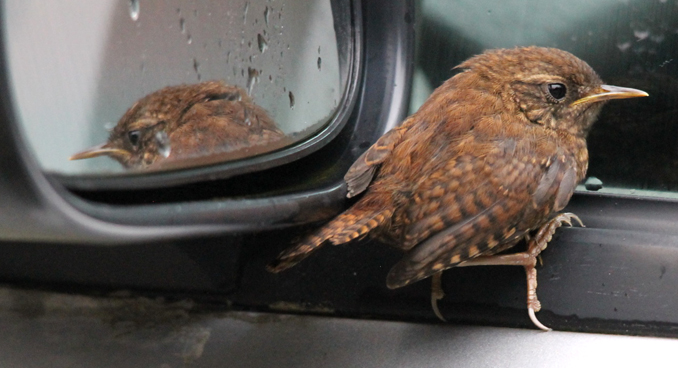This webpage has detailed driving directions from Silicon Valley to Yosemite valley and the Yosemite valley campgrounds / hotels, in two sections:
One set of directions is for people going to Yosemite valley from San Jose, Cupertino, Campbell, Palo Alto, Mountain View, Los Gatos, Saratoga, Los Altos, Los Altos Hills, Monte Sereno, Santa Clara, Milpitas, Gilroy, Morgan Hill, etc. about route 140 (and a few notes about 99/145/41). 140 is the route most people use because it has few steep, winding sections and has less snow in the winter.
A second set of directions covers the 580/205/120 route for people driving to Yosemite from Fremont, Oakland, Hayward, Walnut Creek, Pleasanton, Union City, Livermore, Newark, San Ramon, Castro Valley, etc.
Farther down on this webpage are directions once you get into Yosemite valley.
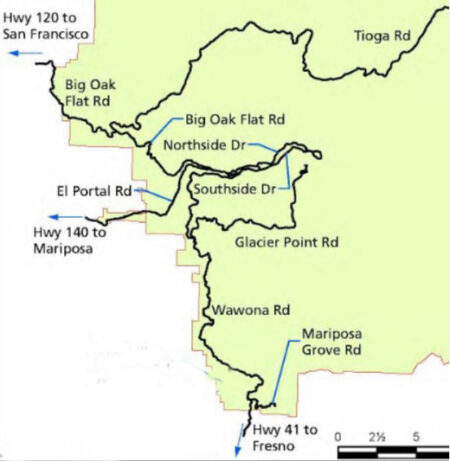
Please note that there are travel driving directions apps that have not been updated to the newest one-way roads in Yosemite Valley. Some still say that parts of Northside drive that are currently one way are still two way, for example, that if you use Sentinel Drive to go from Southside Drive to Northside Drive that Northside Drive will be two way in both directions (it is now one-way in that section). See below for details.
Carpools are arranged among the students going on field trips, not by the club or the college. Often the final arrangements are made at the pre-trip meeting. Snow Camp has all the details about the trip and the date/time of the pre-trip meeting. For info on how to get/give a ride go to Carpool FAQs
For a Yosemite trip you can use public transportation, an Amtrak train most of the way there, then transfer to a YARTS (Yosemite Area Rapid Transit System) bus. YARTS has said: “Enjoy breathtaking views on your journey to Yosemite National Park without worrying about driving. YARTS over-the-road coaches offer a comfortable ride with plenty of storage space, onboard lavatories, ADA accessible seating, and large windows, perfect for enjoying the scenery.”
and yes, the YARTS bus fits in between the ginormous rocks at the Highway 140 (Arch Rock) entrance station:
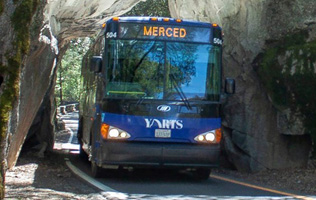
Road trip advice and etiquette has ideas for limiting boredom and some packing and safety tips.
![]()
Yosemite Park entrance fees:
Each vehicle will need to pay the park vehicle entrance fee.
The Yosemite park (valid for seven consecutive days) entrance fee as of early 2024, is $35 per vehicle or $20 per motorcycle. (We do not recommend riding a motorcycle in the winter in Yosemite.)
A Yosemite annual park pass will cost $70.
A National Parks and Federal Recreation Lands Interagency annual pass costs $80 for a year.
or better yet, find someone to carpool with who already has a (National Parks and Federal Recreation Lands) Interagency annual pass. (If you also go on the club Grand Teton National Park trip between summer and fall quarters it could be wise to get a year long pass.)
OR find someone who is an active duty U.S. military member or dependent and has their ID Card (CAC card or form 1173) and can get a free national parks pass http://store.usgs.gov/pass/military.html
OR find someone who is 62 or over to get a lifetime seniors pass for $80.
(The passes can’t be transferred/shared, the pass holder needs to be in your vehicle and show a photo ID.)

We add these notes for the between-summer-and-fall-quarter trip to Grand Teton national park:
Effective June 1, 2018 (and we expect it to be the same in 2026) the park entrance fee will be $35 per vehicle, and an annual (Grand Teton park only) park pass will cost $70.
$35 is for for seven days (only one week and most people go on this trip for more than one week and want to see adjacent Yellowstone National Park as well, which has it’s own weekly fee).
If you stay for more than one week and visit Yellowstone, this would come to $105 if you buy 3 separate $35 passes, so you save money by investing in a $80 National Parks and Federal Recreation Lands annual pass.
Then you will get in free to see other National parks on the way to and from Grand Teton.
The park service warns:
“Please note that GPS units do not always provide accurate directions to or within Yosemite. Yosemite covers 1,200 square miles and does not have a single address. We do not recommend using GPS units for directions in and around Yosemite. If you do use a GPS unit, just keep in mind that if there’s a conflict between what the road sign says and what your GPS unit says, the road sign is correct (and your GPS unit isn’t).”
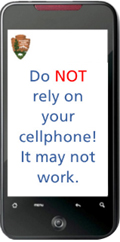 Your cell phone will not function in a lot of Yosemite. You would want a paper road map, rather than trying to get to a map on your cell phone that is not functioning and you need to take a different route than you had planned. (During times that you need to have a reservation to enter the park, – not likely during our late January – early February trip – you would have wanted to print the reservation for your hotel (or campsite, etc.) stay and bring it with you, along with your photo ID, to show the ranger at the entrance station.
Your cell phone will not function in a lot of Yosemite. You would want a paper road map, rather than trying to get to a map on your cell phone that is not functioning and you need to take a different route than you had planned. (During times that you need to have a reservation to enter the park, – not likely during our late January – early February trip – you would have wanted to print the reservation for your hotel (or campsite, etc.) stay and bring it with you, along with your photo ID, to show the ranger at the entrance station.


The park service noted that for those driving into, or through the park some days between 6 a.m. and 2 p.m., (if they do not have a reservation in the park for a hotel, campsite, backpack permit, etc.) a reservation is required. “If entering between 6 am and 2 pm. If you are planning to visit after peak hours, please do not arrive before 2 pm; vehicles blocking roads will be cited.”
“This system ensures all visitors, whether they plan in advance or decide last minute, can experience the park each day. It also spreads visitation across the day so that visitors have a better experience.”
Details about getting peak-hour reservations to enter Yosemite National Park are at:
https://www.nps.gov/yose/planyourvisit/reservations.htm
How long does it take to get to Yosemite?
The drive to Yosemite from the Bay Area can take 4 plus hours if you don’t make many stops, aren’t behind slow drivers and do the speed limit. Or it can take 5-6 or more hours if you have a lot of passengers who want fast food or photo taking stops, or you have to put on chains and drive slowly.
You will probably leave town later than you think because it will take longer to pack up than you think, especially with a big group.
One guy in ’98 didn’t use our directions, he had found some elsewhere on the internet.
He got lost and it took him thirteen hours of driving to get to the park. Yes, 13 hours of driving, some of it well after dark.
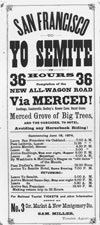 “In 1874, a tourist could leave San Francisco at 7 a.m. and arrive to the Merced Grove of Big Trees at 7 p.m. the next day
“In 1874, a tourist could leave San Francisco at 7 a.m. and arrive to the Merced Grove of Big Trees at 7 p.m. the next day
—a 36-hour journey via wagon road.”
Two Yosemite stages, circa early 1900s:
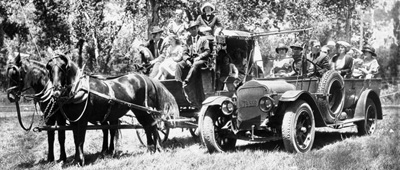
Arthur Holmes and Frank Holmes from San Jose, California, drive a Stanley Steamer on a dirt road in Yosemite with Half Dome in the background, circa 1900:
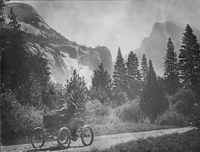
To do in advance of your adventure: You can find the instructions to turn off the loud beep your car makes when you use the keyless ‘remote’ pushbutton on your keychain to unlock the car. Then you won’t forget about it and wake up everyone in the middle of the night. The club requires: If you park at the campground or anywhere next to hotel buildings / cabins you will turn off your car alarm. You will disable the loud beep that goes off when the keyless remote is used to unlock the car OR you will take the remote off the keychain and use the key to unlock the door(s). You will disable the beep that goes off when the trunk is opened / any other beep. In the interests of letting others sleep, if you can’t disable the beep(s) (or disconnect the beepers) you will not drive that vehicle or you will park it at a day use parking lot.
If you rent a vehicle please learn how to turn off car alarms/disable beeps at the rental business, BEFORE you leave for the trip. (AND if you rent a vehicle make sure well in advance they will let you use chains on it, as you are required to carry chains all winter even if it does not seem like you will need them!) It has snowed in Yosemite valley in April and chains were required.
The Yosemite garage can handle most minor emergency repairs such as battery charge, radiators, water pumps, brakes and tire repairs, (IF they happen to have a needed part in stock, otherwise they will have to order it or you will need to look for help elsewhere, which could include expensive towing out of the park, so people are advised to check everything that powers, stops, cools, heats, ventilates and lights their vehicle before they leave on an adventure. Check the windshield wipers, defroster, exhaust system, antifreeze level and tire pressure.) Road trip vehicle prep and recommended service has checklists and things people can do themselves.
If the owner of the Buick below had cleaned the battery terminals before the trip the half hour spent trying to get his car to start on the 2016 trip could have been spent on something more fun. Read more at Prepare for winter driving
–Keep at least a half-full gas tank (to prevent gas line freezeup). Why? Any space above the gas in the tank has moist air in it. In the cold, especially overnight, that can condense into water. The water will sink to the bottom of the tank and if enough builds up it can end up going to your fuel line and cause hard starting or even block the fuel line completely.
Any time of the year, you’ll also want to keep a closer to full tank should you need to change routes, idle, drive slowly or turn back. PLUS after the eventually expected big earthquake, during PG&E rolling blackouts, (whenever the power is off), you can’t pump gas and might not be able to get home from school/work/shopping, so keeping a half tank of fuel can be a good habit.
This warning from Canada can apply to any long-distant drive: “Visitors to large cities and popular tourist destinations should be aware that parked cars are regularly targeted for opportunistic smash-and-grab thefts, and they are cautioned to avoid leaving any unattended possessions in a vehicle, even in the trunk. Due to the high incidence of such crimes, motorists in Montreal, Toronto, Vancouver and some other jurisdictions can be fined for leaving their car doors unlocked or for leaving valuables in view. Visitors should exercise precaution to safeguard their property.”
Another source mentioned smashed windows when car thieves target property left in plain sight
such as luggage, purses, electronics, laptops, tablets, and even expensive sunglasses.
JUST BEFORE YOU LEAVE:

Possible delays due to road work or completely closed roads in Yosemite are at: https://www.nps.gov/yose/planyourvisit/conditions.htm in the Road Status section. “Work is subject to change due to traffic incidents, weather, availability of equipment and/or materials, and/or construction-related issues. Please drive carefully and watch for warning signs, workers and equipment in the roadway.”
The National Weather Service has a map of predicted fog severity at:
https://www.weather.gov/hnx/HNXFogSI.html This below is not the current one, but just an example and the one at the webpage is much easier to read:
The National Weather Service has an expected snow fall map at: https://www.weather.gov/hnx/winter The one below is not current, but is offered as an example:

Just before you leave, call 1 800 427-7623. It is voice activated, so say 140 or 580/205/120 or whatever highway number for road conditions, detours, etc. The Yosemite road and weather phone message is 1 (209) 372-0200.
CALL the road info number before you leave town, and perhaps again during your drive!
Besides rock slide closures, hazardous tree removal or road paving may be planned along your route.
Below rockfall during a January storm:
and the slide on Highway 140 that closed it starting in March 2025, and then went to one-way with traffic control:
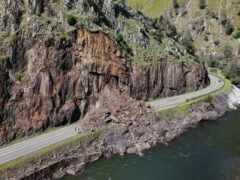
The Park service has noted: “drivers are reminded of the greater likelihood of encountering rock debris on park roads during wet weather. Although rockfalls are always possible along all park roadways, they tend to happen more often during winter storms. . .
If you encounter small rock debris on the road, drive through the area (do not stop within the debris) and promptly report it to Park Dispatch. Do not attempt to remove the debris yourself – leave that task to road crews equipped to do so safely. If you encounter large rock debris on the road, turn around and promptly report it to Park Dispatch.”
Having a at least half full gas tank gives you a better opportunity to change routes, idle, drive slowly or turn back, and especially to turn around and take another route if you do not find out about a road closure before you leave town or if it becomes closed when you are already on your way to the park.
The park can’t put up signs warning of every weather related hazard, so moderate speed driving is always recommended, and it is wise to turn off cruise control when conditions are wet.
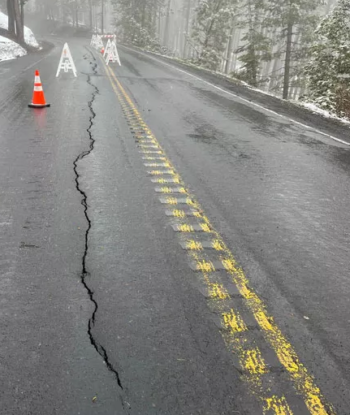
When Big Oak Flat Road in Yosemite National Park was closed in May 2023,
“the road has a crack that is about 200 feet long and up to four feet deep. The road surface has moved two to three inches vertically and horizontally and is continuing to move. The embankment below the road has moved as much as 15 feet downslope and has significant water flow through it. It is not safe to open the road even to limited traffic, and doing so would likely lead to additional road failure.”
And after some repairs, the road had three single-lane sections controlled by traffic lights.
– – – – – – – – – – – – – – – – – – – – – – – – – – – – – – – – – – – – – – – – – –
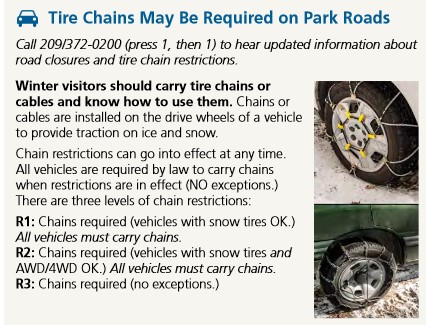

(Very rarely) there can be enough snowfall in one storm
to temporarily close all roads into Yosemite Valley
and it can take one or more days to clear all the roads, so you should not have a tight schedule to get home. (140 is usually cleared before 120.)
During huge snowstorms snow can pile up at 2-4 inches per hour, and snowplow crews are unlikely to keep up with that rate while the storm is active.
It would be wise to have a map of, and take a look in advance at, alternate routes that might be your new way home if only one of the roads out of the valley opens up.
Here, an entrance station after a big storm:
Expect slippery ice around each parking space edge after snowfall. The parking lot lanes are plowed, but the parking spaces are not plowed:
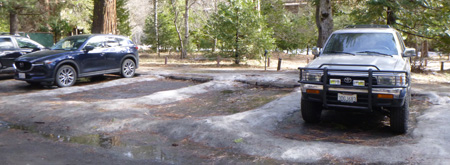
Some GPS units have misled people and they are found wandering around the vicinity of the Search and Rescue offices instead of finding their hotel/campsite. Please get a map and use it and read the posted road signs. Either buy a map, or CSAA (also known as Triple A) members should pick up a free Central California, Bay Area to Lake Tahoe and Yosemite, map.
Most people will take the route (140) with the possibility of not having to put on chains until the very last minute (or maybe not at all). In ’98, when there were flood watches all over the state, there was no flooding on this route.
You could take 120 instead of 140, but you will be much more likely to have to use chains, and here’s a picture of the self-service gas station (partially dug out of the snow) at Crane Flat on that route:
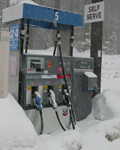
Some online map services recommend the Chowchilla Mountain Road as a direct route into Yosemite. The concessionaire warns “Unless you are interested in 4-wheeling on this rutted dirt road, Highway 140 is a much faster option.” There has been a sign on the road says: “impassible not maintained during winter Nov to May.” Some years it is closed for the winter.
– – – – – – – – – – – – – – – – – – – – – – – – – – – – – – – – – – – – – – – – – – – – – – – – – – – – – – – – – –
Oakhurst or Mariposa, your last two big towns before you enter the park using the 140 or 41 routes, are fairly big Sierra towns, with a major sized grocery and lots of restaurants plus a choice of gas stations (more expensive than home). It might be worth your time if you’re on a budget to drive a few blocks through town looking for the cheapest station as occasionally they have a gas price competition.
Fill up with gas at whichever town is on your route. There are no gas stations in Yosemite valley. If you run out of gas or almost run out of gas in Yosemite valley, and would not be able to get to the nearby-but-not-close gas stations (see next paragraph) the garage often has 5 gallon containers of gas to sell AAA / CSAA members, when it is open.
The nearest gas station for our trip, miles from the campground / hotels/ cabins, will be in El Portal (in recent years at least a dollar a gallon more than Mariposa) or within the park at Crane Flat (30 minutes from Yosemite valley) or Wawona (about an hour from Yosemite Valley) each 24 hours with credit or debit card at the pump, IF the pumps are functioning. (Rarely the gas pumps are not available, for example when they are doing an Air Pollution Control Test, or when Mariposa County inspects the fuel tanks, a downtime of 2 or 3 or 4 hours can be expected and when Fuel bank systems are being upgraded stations will not be open for business on the day of installation. When repairs are needed, downtime can be days “pending the arrival of replacement parts.”)
You should keep at least a half-full gas tank (to prevent gas line freeze-up), or a closer to full tank should you need to change routes, idle, drive slowly or turn back. So fill up at the last major town before entering the park. If you didn’t bring chains, you can usually rent and/or buy them in Oakhurst or Mariposa as well (if you can find any that fit on your tires).
If it’s cold, Mariposa or Oakhurst would be a propitious place on a winter trip to put on those polypro longjohns / base layer and change into boots. Some years there is little snow on the ground, some years lots. As you drive, be ready to stop around a corner on winding mountain roads for work crews, a fallen tree or a tourist stopping in the road to take a picture. If trees are full of snow be prepared for a huge snow plop on your windshield.
Up into the mountains there may be a sign saying whether chains will be required that day on the Yosemite route. You probably won’t need to put them on until farther up the road if they are required; the sign may just be a warning. If Yosemite is having early-spring-type weather and you decided to risk not bringing chains, don’t congratulate yourself too soon, things can change by tomorrow. Don’t forget, you can’t rent chains in Yosemite, they are very expensive to buy, and even four-wheel drive vehicles with snow tires are required to have chains. Often the Rangers check for chains and won’t let you into the park if you don’t have them. AND not having chains “could subject you to an expensive citation.”
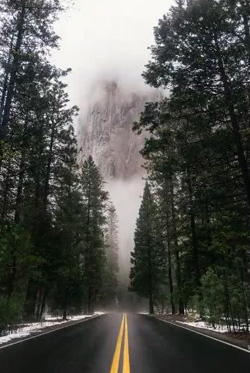
Roads in the valley are plowed more often than some outside of the valley, but can get a fresh coating of snow,
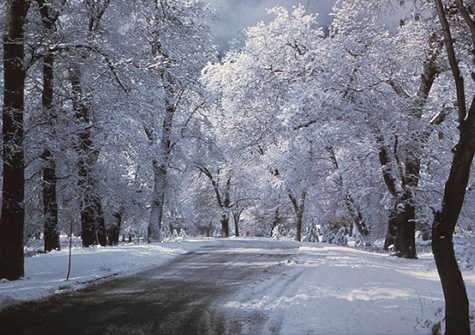
so plan enough time to take it slow and always have those required snow chains. As the park says: “Snowy or icy road conditions are common in the mountains of California, including Yosemite, from fall through spring. When these conditions exist, federal regulations (in Yosemite) and state law (outside Yosemite) require that you use chains or cables in order to reduce the chances of accidents. Chain requirements are strictly enforced.”
Slow down and skip this experience…
From the National Park Service Morning Report, Monday, January 22, 2007
Yosemite National Park
Visitors Rescued From Vehicle In River
On January, 11th, a winter storm passed over the park, producing little snow but creating very icy road conditions. Although crews treated park roads and rangers put four-wheel-drive or snow chain restrictions into effect, a Nissan Pathfinder slid off Highway 140 near Pohono Bridge shortly after passing a chain control area. According to the initial report, everyone was out of the vehicle and there were no injuries. Park telecommunication supervisor David Thorpe was in the area, though, and provided additional information. Thorpe, who is also a Mariposa County swiftwater rescuer, told rangers that the Pathfinder began rocking when the occupants were attempting to get out, suggesting that it was unstable; the evacuation was accordingly stopped until the vehicle could be stabilized. Still inside in the front passenger seat was a 62-year-old man with an artificial hip and restricted mobility. That part of the vehicle, including the tire and bumper, were touching a deep pool of swiftly moving water. Rangers, Yosemite SAR personnel and members of two fire battalions responded. The Pathfinder was secured and the man was carefully extricated and raised up a slick, rough scree slope in a litter. Meanwhile, traffic management personnel, road crews and tow trucks from the Valley worked at sanding the road, managing the closure, and moving other vehicles involved in collisions back onto the roadway. The icy conditions were caused by frozen rain falling on the roadway. Although there wasn’t much of an accumulation, the compressed particles created a very slick surface. [Submitted by Jason Gayeski, Valley Patrol]
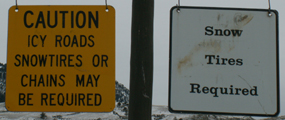
Read through this while looking at a map.
(For people going to Yosemite valley from Silicon Valley (San Jose, Cupertino, Campbell, Palo Alto, Mountain View, Los Gatos, Saratoga, Los Altos, Los Altos Hills, Monte Sereno, Santa Clara, Milpitas, Gilroy, Morgan Hill), take 101 South to Gilroy.
In Gilroy exit on 152 East, and go to the left over the 101 freeway. If you forgot something, turn right just after going over 101 into a large shopping center with a Target and fast food places for restrooms and road trip provisions.
152 East takes you over Pacheco Pass, which is a much improved road, if you haven’t driven it the last few years. It has been widened with passing lanes, and the road is much safer and easier to drive. After about 14 miles, go on to the 152/156 branch towards Los Banos.
After San Luis reservoir, continue on 152 over I-5 and down into Los Banos, with more fast food places. If it’s cold out now, you might want to put on those long-johns.
This section of 152 is also called highway 33 and/or West Pacheco Blvd on some maps. On the right and back in a little at the intersection of Badger Flat road is a Target for a little food and whatever else you suddenly realized you forgot. We find it a convenient grocery stop /restroom stop on the way home from Yosemite trips.
After Los Banos travel on 152 east for about 18 miles and make a decision to take either
59 North towards Merced, then 140 to Mariposa,
UNLESS you call and find out there has been a rockslide and 140 is closed
OR decide to stay on 152, then head south on 99 to Madera, go up 145 and 41 to Oakhurst. We’re not giving as many details of the longer drive through Oakhurst, so if you choose that route, (or road conditions force you to use that route) skip ahead to the purple-colored paragraphs .
If you decide to take 59 north, pay attention, the overpass is easy to overlook. Watch for the San Joaquin bypass shortly before it. Stay on 59 north for about 15 miles to Merced. Get on 99 for about twenty thousand milliseconds (okay, less than 30 seconds), then exit on to 140 east. After about 37 miles, get gas in Mariposa. (Again, gas closer to the park, at El Portal, for example, is going to be much more expensive.)
Along this route, past Mariposa, but before El Portal and the entrance station, is a one-way-at-a-time section of road with a relatively short duration stoplight. Even if you do not see traffic approaching, the red light is a real red light. Starting to drive along this section when the light is red can leave you in the unenviable situation of trying to drive in reverse while a string of cars that was approaching waits for you to get out of the way. (Yes, we saw this happen.)
The park had these notes in 2021 about the this section of road:
“Caltrans To Resume Work On Ferguson Project
The California Department of Transportation (Caltrans) is preparing to continue work at the site of the Ferguson Rock Shed project on State Route 140 in Mariposa County. In the first phase of the construction project, workers will remove overhanging boulders and rubble from the slope where a rockslide blocked the roadway. Crews are scheduled to conduct this work during daytime hours beginning in April and continuing into the winter season of 2021. Traffic impacts are expected to be minimal. The Ferguson Rock Shed Project https://dot.ca.gov/caltrans-near-me/district-10/district-10-current-projects/ferguson-slide-project/ferguson-rock-shed-project-photos-videos will ensure motorists have safe access to Yosemite National Park via Route 140. Construction of the rock shed is scheduled to begin the summer of 2022. This work is scheduled is subject to change due to traffic incidents, weather, availability of equipment, and/or materials and construction related issues.”
In late May some years, Highway 140 between Crane Creek and the Yosemite National Park border (Parkline) in El Portal becomes “thick with thousands of California tortoiseshell butterflies. This species emerges in spectacular numbers in some years and is thought to be the source of Mariposa County’s name, which is Spanish for butterfly.
Please help minimize the number of butterflies killed by reducing your speed when you encounter their swarms. At 25 mph, the butterflies are more likely to follow the slipstream around your car, and emerge unscathed. At higher speeds the butterflies don’t fare as well. Dead butterflies along the roadway also increase the risk to the birds that come to feast on the dead butterflies.”
Take 140 east about 34 miles to the Arch Rock entrance station (if this part is open–call before you leave home!).
If you decide to come into the park on 140 and through the Arch Rock Entrance Station, please be advised to watch out for pedestrians crossing the road suddenly to get a picture
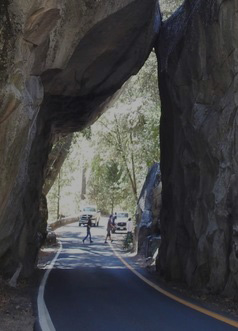
Are we there yet? Not quite, your campsite or room is still about a half hour away. (In the summer it can be much longer by mid-day as the traffic can get quite backed up.) Restrooms just past the entrance station are on the right. The restrooms are usually open even when the entrance station is closed. If they are closed, a few miles up the road on the right there is a parking area with a small building with toilets.
As you continue, the Merced River will be on your right.
Here are notes for the 580/205/120 route, everyone else should skip ahead:
Trying to shortcut through Livermore on 84 can take more time at stoplights than the longer route of 680 to 580.
After Altamont Pass, leave 580 and get on 205,
205 joins 5 for a brief way, then head on to 120, go past Manteca and on to 99 north using a left lane split, and look for the next quick exit east on 120.
Most of the rest of the route will be on slow roads rather than freeways, some of it through towns that really want you to do the posted speed limit.
In Oakdale you will make a left turn at a light to continue on 120 east. At Yosemite Junction you will make a right (no light or stop sign in your direction at this intersection).
For the section between Don Pedro Reservoir and Groveland, use Priest Grade, DON’T try OLD Priest Grade. If it is at all hot weather, turn off your air conditioner as you drive the eight miles, sixty curves and switchbacks of Priest Grade, even if your car is in great condition. Don’t turn the air conditioner back on right away when you get to the seeming top at Big Oak Flat. There is still some steep uphill through Priest Station. At the elevation 3000′ sign more typical mountain down and up hill starts.
Next stop is the the Yosemite National Park Big Oak Flat entrance station, with a visitor center with restrooms on the right. Now could be a good time on a winter trip to put on the long johns / base layer and switch from tennis shoes to winter boots.
Plans to upgrade / replace the Big Oak Flat Welcome Center entrance station buildings, parking are at:
https://www.nps.gov/yose/getinvolved/upload/YOSE-BOF-Public-Review-EA_FINAL_508.pdf
Nine miles farther you might want to top off your tank at Crane Flat in case you want to do extra driving while in the park. There is a one way road/driveway into the station. It is not staffed in winter, but most of the time you can pay at the pump with a credit card. (This station frequently has lower prices than some of the little stations just outside the park entrance.) At Crane Flat there is usually a snow play area. 3.5 miles north of Crane Flat you can take a 4 mile round trip hike or ski into the Merced Grove of Giant Sequoias.
Are we there yet? Not quite, it’s 16 miles from Crane Flat to Yosemite Valley campgrounds or hotel rooms.
A bit after a few tunnels (be courteous to bike riders!) when this road enters Yosemite Valley, you will stop at a stop sign and turn left. As you continue, the Merced River will be on your right.
 Whenever any kind of chain controls are in place the speed limit is 25 miles per hour. Leaving a big following distance could be a great idea, especially when you are approaching a stop sign, so you don’t slide on ice when you brake and find yourself unable to stop before you hit the car in front of you that was stopped for that stop sign.
Whenever any kind of chain controls are in place the speed limit is 25 miles per hour. Leaving a big following distance could be a great idea, especially when you are approaching a stop sign, so you don’t slide on ice when you brake and find yourself unable to stop before you hit the car in front of you that was stopped for that stop sign.
Routes 140, 580/205/120 join at this point, down in Yosemite Valley.
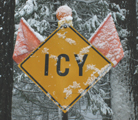
Here in central valley and coastal California most of our roads will not freeze very often as the ground beneath doesn’t get that cold, so ice will only form occasionally in patches or after freezing rain.
But as you approach bridges, slow down. Black ice (a thin, invisible, complete coating of ice) forms on top of bridges, causeways or any stretch of road not paved over solid ground.
Black ice can occur even when the weather is dry. Melting water from roadside snow banks often freezes on road curves during early evening hours and stays frozen. Black ice can look like dry pavement .
It can take you three times the normal distance to stop when a road is icy (even with anti-lock brakes, four wheel drive and snow tires). Spin-outs are common in the winter in Yosemite. Leave a good following distance. Slow down well in advance of stop signs. Expect people coming from another direction to not be able to stop and to slide into the intersection (and possibly into you).
When you cross the river on the Pohono bridge 5+ miles from the entrance station, the road becomes a one way loop (unless there has been a rockfall on part of it, or of the park is doing road repairs on the outgoing part of the loop, then it could be two-way). Just before the bridge, coming towards you from the left is Northside Drive (usually) one-way. Don’t be one of the people who does not see the signs telling them to not drive on Northside Drive.
Southside Drive runs almost the length of Yosemite valley, in a one way direction west-to-east, as outlined in red in the map section below:

or as seen in this drawing
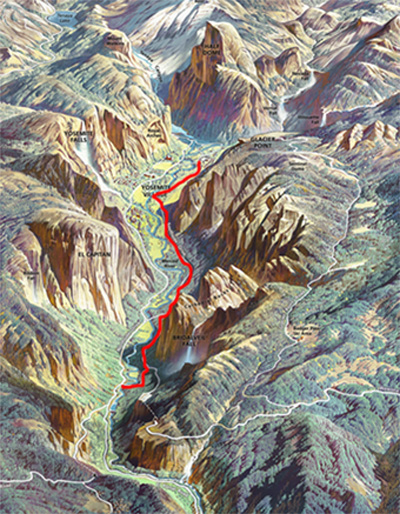
You can see a full sized copy of this drawing (without the red line I added) at https://npgallery.nps.gov/HFC/AssetDetail/1fe70b41-8920-4744-a1b6-203c12fe84eb
After crossing the bridge, as you go along the next section of Southside Drive you will catch glimpses of the Merced River on your left:
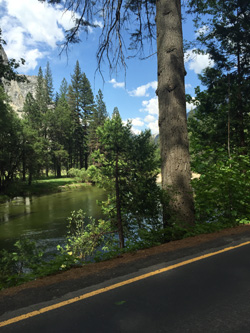
If you are in the right hand lane you might find room for your vehicle in a small turnout on the right to see Fern Spring:
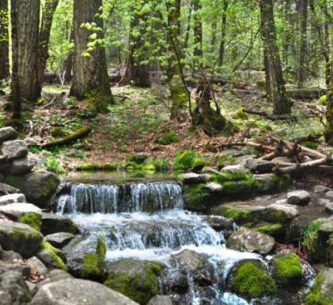
Along the upcoming section of road is a John Muir display many people look for in Yosemite, a sign at a turnout on southside drive where John Muir camped with Theodore Roosevelt. The park service wrote about their camping trip together: “Roosevelt had sent Muir a letter asking to meet him in Yosemite: “I want to drop politics absolutely for four days and just be out in the open with you.” At their meeting, Muir spoke of environmental degradation, like development, and asked for another layer of protection as a national park to improve management. Muir convinced both Roosevelt and California Governor George Pardee, on that excursion, to recede the state grant and make the Valley and the Mariposa Grove part of Yosemite National Park.” This was the start of Yosemite National Park.
This sign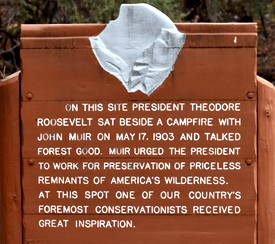 is at a turnout on the right hand side of Southside drive, 0.45 miles east of Pohono Bridge, where Southside Drive first comes away from the river.
is at a turnout on the right hand side of Southside drive, 0.45 miles east of Pohono Bridge, where Southside Drive first comes away from the river.
and see also how to find the short walk to the location of John Muir’s cabin (hang nest) and sawmill in Yosemite Valley.
A little later, from the right, the road (highway 41) from Oakhurst/to Badger Pass “Wawona Road” on the map below, joins this route.
– – – – – – – – – – – – – – – – – – – – – – – – – – – – – – – – – – – – – – – – – –
– – – – – – – – – – – – – – – – – – – – – – – – – – – – – – – – – – – – – – – – – –
If you choose the Madera/Oakhurst route, from Oakhurst you’ll go north on 41 through National Forest land to the South entrance station. If you come in late the Ranger kiosk will be closed. Are we there yet? Not quite, your campsite is still about an hour and a half away.
It’s 5 miles to Wawona, with the big white hotel buildings, golf course, gas station and small store, then it’s 12 miles to the turnoff for the ski resort (by here you may need chains), then about 7 miles to a long tunnel just above the valley floor.
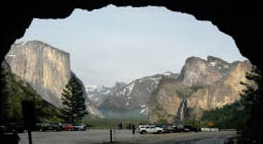 Slow down and put on your right blinker at the end of the tunnel and pull carefully into the small parking lot. Walk across the road (watch out for drivers watching the scenery and not seeing you) to the main Tunnel View viewpoint.
Slow down and put on your right blinker at the end of the tunnel and pull carefully into the small parking lot. Walk across the road (watch out for drivers watching the scenery and not seeing you) to the main Tunnel View viewpoint.
– – – – – – – – – – – – – – – – – – – – – – – – – – – – – – – – – – – – – – – – – –
– – – – – – – – – – – – – – – – – – – – – – – – – – – – – – – – – – – – – – – – – –
OR IF YOU TOOK 120 or 140), a detour to Tunnel View (see more pictures below) can be quite worthwhile especially if you are coming into the park in daylight.
NPS photo of Tunnel View (the massive rock form on the left is El Capitan, in the background in the center is Half Dome, the waterfall on the right is Bridalveil Fall:
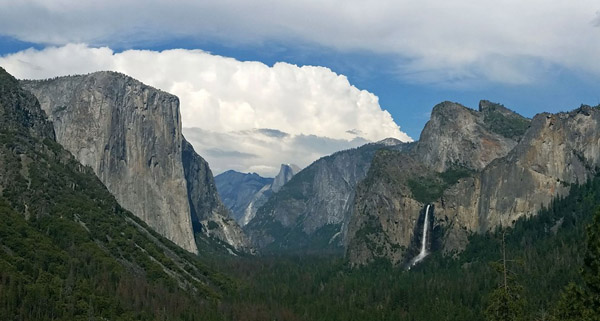
Different times of the year there will be different amounts of snow:

This view is worth stopping for even if you are running late and even if there is rain or snow falling. The Yosemite Fund (now called the Yosemite Conservancy) and the National Park Service funded a remodel in 2008 with educational exhibits, expanded handicap accessible viewing area and improved traffic flow. Thousands of people stop each day in the summer.
Google maps 360 degree street view at Tunnel View.
The red X below is where Tunnel View is (the dotted line below the red X is the tunnel):
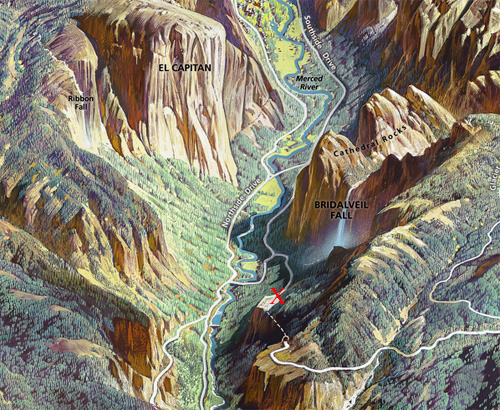
The two parking lots, one on each side of the road, have a small number of parking spaces:
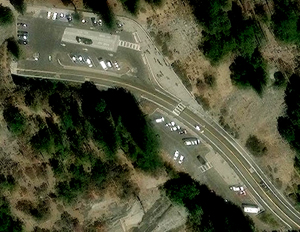
Many drivers who are watching the scenery do not notice the crosswalk between the two parking lots. If you plan ahead while driving through the area, you can slow down and look for people waiting to cross:
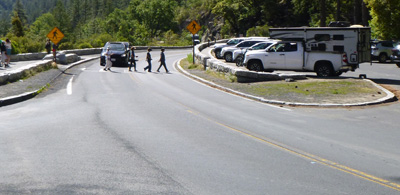
The larger of the two parking lots has a bus parking only section:
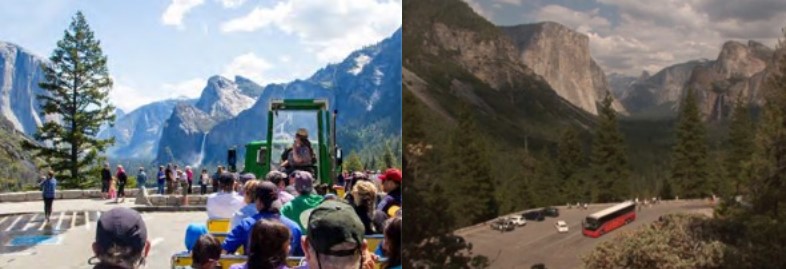
At the edge of the larger parking lot is a paved section for photographers with a low wall:

Webcam near Tunnel View located on a dome near the Wawona Tunnel:
https://www.nps.gov/customcf/webcam/dsp_webcam_image.cfm?id=81B464D8-1DD8-B71B-0B27F29DCD4CE913
More photos of the view from the parking lot at tunnel view:
photos below by Quang-Tuan Luong/terragalleria.com, all rights reserved.

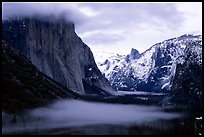
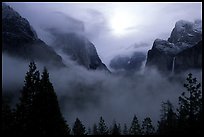
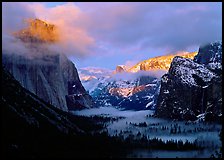
Coming down to the valley after you stop at Tunnel view, in about a mile and a half,
look for the turnout on the right to Bridalveil Fall. https://www.nps.gov/yose/getinvolved/bridalveilea.htm explains work on restoration of the Bridalveil Fall area.
It’s only a five minute walk to the base of the fall.
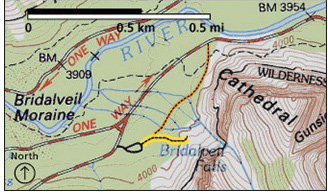
Bridalveil fall in September, with just a wisp of water, and in February 2017, with full flow: and in December:
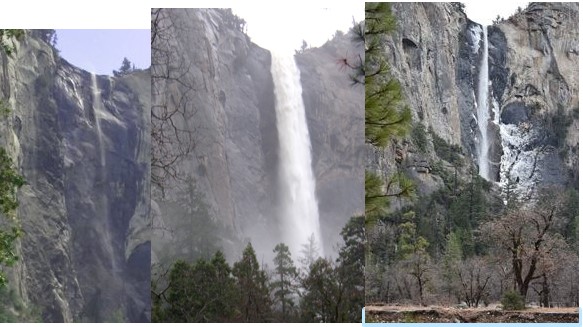
after the Bridalveil Fall turnoff, the Wawona Road next joins Southside drive and the road becomes a one-way loop, unless there has been a rock fall or road construction and it is designated two way.
Again, Southside Drive runs almost the length of Yosemite valley, in a one way direction west-to-east, as outlined in red in the map section below:

The NPS map below has the parking area closest to Bridalveil fall (Bridalveil Fall parking lot, mentioned above on the way down to the valley from Wawona, Tunnel View) marked with a large P
and in almost the center of the map, a smaller P with the location of the long paved turnouts pictured below.
see more details and photos at places in Yosemite Valley to take photos of Bridalveil fall.
Further along (usually one-way) Southside drive into Yosemite valley, (0.25 miles east of the intersection of Southside Drive and Wawona Road) there are long paved turnouts on both sides of the road with a view of El Capitan on the left
and Bridalveil Fall on the right, where a long trail to Bridalveil fall comes out to the road.
Bridalveil Straight was redesigned in 2022. Note that if you want to stop here, as you approach you should be in the left hand lane to find a parking space, as much of the right hand lane is a no parking zone designated for shuttle buses and tour buses. (The four thin blue rectangles in the map below are to show busses.)
Sometimes one or more roads are closed suddenly due to a rock fall / mud slide that needs to be cleared. Roads that were two lanes in the same one-way direction can need to be be designated as two-way. Watch for signage.
WATCH OUT!!! and please be assured that some drivers will not notice the changes, even with multiple signs. (There was a large sign with flashing lights at the beginning of this section of road designating this change and then four of these yellow double arrow signs alongside the road on both sides. We watched multiple vehicles drive in the wrong lane for part or all of this section of road.)
__________________________________________
__________________________________________
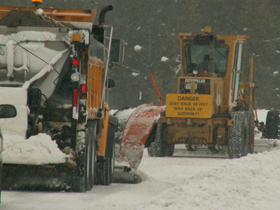 Drive extra carefully from now on, there may be a snowplow working around the next corner, someone stopped to take pictures who didn’t pull far enough off the road (or just stopped in the roadway), or people weaving over the center line as they drive and sightsee.
Drive extra carefully from now on, there may be a snowplow working around the next corner, someone stopped to take pictures who didn’t pull far enough off the road (or just stopped in the roadway), or people weaving over the center line as they drive and sightsee.
Was that a coyote already?
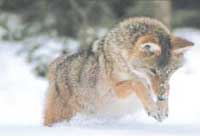
The following is the description if all regular roads are open. If there are closures there will be signs redirecting you.
In the summer this section of road can have a bus/emergency vehicle lane in place and drivers of private vehicles must stay in the left lane. Signage is put up when this is in effect.
Follow signs that say “to all Valley Destinations” for about five miles. The river will be on the left side of the road, although you won’t be able to see it at times.
You’ll go past a few turnoffs to picnic areas. There will be a stretch of road with meadows on both sides and parking on the left where you can stop and see Yosemite Falls on the left, or Half Dome a bit farther on the right.
Here are two NPS pictures (and a third and fourth of mine) of what the view of Yosemite Falls might look like in the winter along this stretch of road:

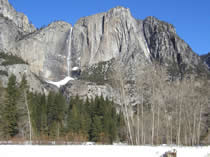


and one of the boardwalks next to the parking, across the meadow in May:
In the NPS photo below of flooded Sentinel Meadow taken May 16, 2005, you can just make out the sunken edge of the boardwalk across the meadow between the two posts on the fence and can just see Yosemite Falls thru the low clouds in the background. Next to it is the same place in June, 2005 and again in February 2008
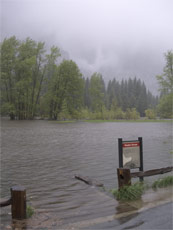

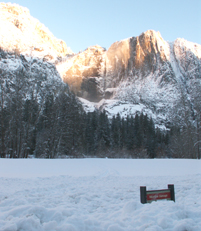
– – – – – – – – – – – – – – – – – – – – – – – – – – – – – – – – – – – – – – – – – – – – – – – – – – – – – – – – – –
Here is the view of Yosemite falls from the parking on the left hand side of the road
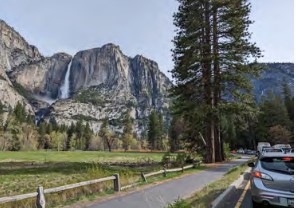
and here is the view from the top of Yosemite falls looking down at this strip of parking spaces on Southside Drive:
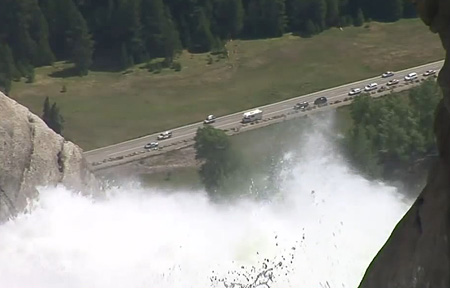
If you have a few extra minutes and can find parking on the left hand side of the road,
a short walk takes you to a display about massive flooding when Yosemite valley has turned into a lake. At the end of the left hand side of Southside Drive long parking strip, directly across from the chapel,
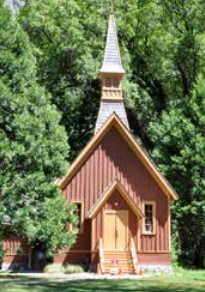
follow a path towards a pedestrian bridge over the river.
The map below of free day use parking lots shows the chapel in about the middle of the map, and a dotted red line showing the path to the bridge. The bridge is just below the letter “M” in the words Yosemite Valley Lodge in the map below.
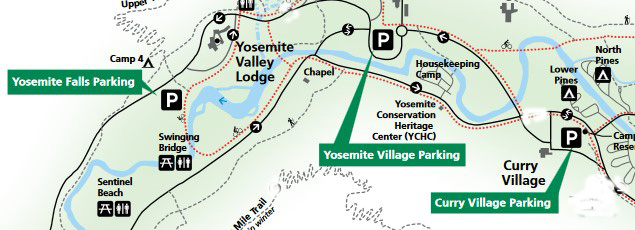
The bridge is in the upper left hand side of this photo:
You can stand next to the display
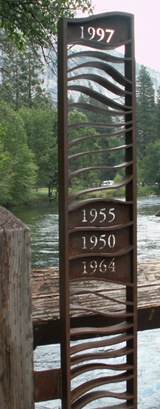 and see that the water flooding over the bridge in 1997 would have been up to the chin of many adults (had they been able to stand on the bridge at all).
and see that the water flooding over the bridge in 1997 would have been up to the chin of many adults (had they been able to stand on the bridge at all).
A description of the flood display and more photos are at: Yosemite floods display on Superintendent’s Bridge. And find photos of a longer walk in the area at Cook’s Meadow.
Shortly past the Chapel on the right, you arrive at an intersection before Sentinel bridge to the left across the river.
The blue dot on the map below is this next intersection:
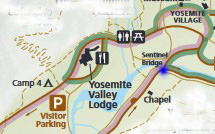
Plan to be in the correct lane for your destination.
And watch out for people who are not sure of which lane to be in who decide to suddenly change lanes in the middle of the intersection, or even stop in the traffic lane to consult a map. OR rarely, but it happens, who drive part way along the right hand lane, past the left hand turn they needed to get to the Lodge, and then try to back up in that lane, even for many car lengths.
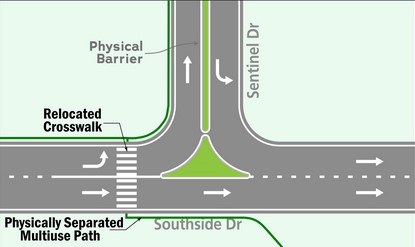
People going to the Yosemite Lodge, Yosemite Falls free day-use parking lot, trailhead for the Yosemite Falls hike and Camp 4 should be in the left hand lane and turn left and go over the bridge. Yes, you will be driving on the left hand side of the bridge, but there is an inches tall, wide barrier to separate traffic.
Here is the view as a vehicle turns on to Sentinel bridge from Southside Drive in the proper lane:
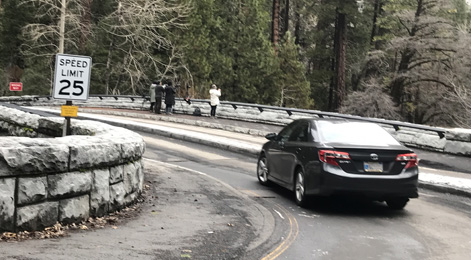
Here a view from the far side of Sentinel Bridge with a vehicle coming from Southside Drive across Sentinel bridge (right hand lane)
and a truck coming from Northside Drive on Sentinel Drive towards the bridge (left hand lane)
in what feels like the wrong lane to be in, even when you have done it quite a few times
(note the width and height of the barrier between the lanes):
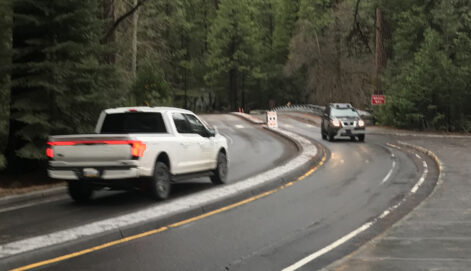
If someone drives past and around the middle-of-the-road barrier (shown in the map below as the word barrier in the green almost-a-triangle)

and starts to drive the wrong way on Sentinel Bridge, they will find multiple signs saying wrong way:

We watched one day as a driver turned left from Southside Drive onto the wrong lane on the bridge. Pedestrians on the bridge sidewalk chased after her, waving their arms and stopped her past the second Wrong Way sign.
She then backed up off the bridge
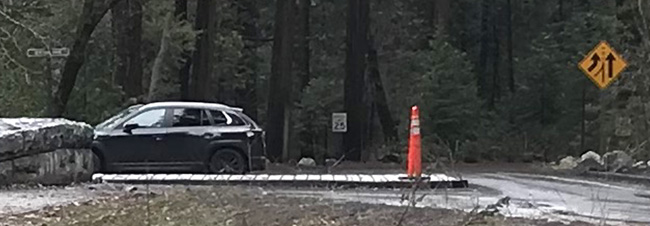
and instead of turning and continuing on Southside Drive in the proper direction, turned around, went around the large barrier and seemed to be heading for the proper lane to cross the bridge.

But instead she put on her emergency flashers and drove back the way she originally came on Southside Drive, with traffic coming at her,
as she was driving the wrong way on the 2-lanes-in-one-direction road.

As she passed us, we were on a path near her side of the road, facing her and waving our arms widely and frantically (and we saw a cell phone up to her head).
Watch out when approaching this intersection.
and note that this is not the only section of the one way roads that circle Yosemite valley
that you can find wrong-way drivers on.
– – – – – – – – – – – – – – – – – – – – – – – – – – – – – – – – – – – – – – – – – –
– – – – – – – – – – – – – – – – – – – – – – – – – – – – – – – – – – – – – – – – – –
After sunset Sentinel bridge may have lots of photographers trying to get a picture of Half Dome with pink or gold color
and if the water is flat enough, the reflection in the Merced River, as in the NPS photo below:
– – – – – – – – – – – – – – – – – – – – – – – – – – – – – – – – – – –
If you turn left over the bridge, the road bears right and then bears left on to Northside Drive, where oncoming traffic in the other lane is coming from the east end of Yosemite valley.
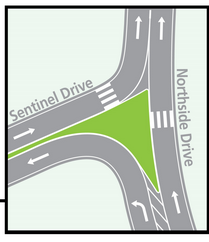
People going to Yosemite Valley Lodge can find maps of the hotel and area at Yosemite Valley Lodge. Please note the entrance into the Lodge complex that we recommend you do not use.
People going to Camp 4 can find a map at Camp 4 (four) Map.
– – – – – – – – – – – – – – – – – – – – – – – – – – – – – – – – – – – – – – – – – – – – – – – – – – – – – – –
Straight ahead after the intersection at Sentinel Bridge is two lanes in one direction,
if signs tell you to, get in the left lane because the right hand lane is for buses/ambulances only, as are some other roads in the valley, some times of the year.
In busy traffic times, if you get tired of waiting for traffic to move, and think you don’t see an officer, so you move into the bus only lane, you might find two law enforcement rangers on bikes stopping you:
– – – – – – – – – – – – – – – – – – – – – – – – – – – – – – – – – – – – – – – – – – – – – – – – – – – – – – – – – –
When you drive straight ahead instead of turning left over Sentinel Bridge,
you then go past Housekeeping Camp on the left with the laundromat (sometimes open all year even in winter when Housekeeping Camp is closed). To find the laundromat, bear left when you enter the parking lot.
Past some employee housing on the right, (if you arrive after dark in winter you might see the lights of the ice rink), this usually one-way section of road comes to an intersection that previously had stop signs and two-way traffic.
Plan ahead which lane to be in as you approach this next intersection.
During high traffic times, especially on busy weekends in the summer, traffic at this intersection can be backed up for many car lengths.
A ranger might be directing people who do not have reservations for Curry Village or a Pines campsite to turn left and not try to park in the full parking lots to the right.
Or there might be different signage,
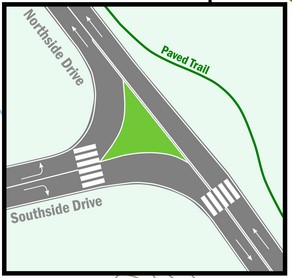
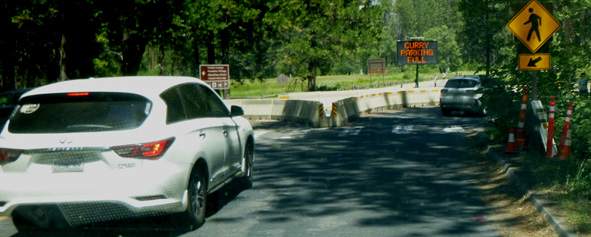
Be in the right hand lane and turn right to go to Curry Village Curry Village free day use parking lot, Curry Village (briefly named Half Dome Village), with the wood floor canvas roofed/walled tent cabins and the Pines campgrounds.
After your right hand turn into Curry you will pass the charging stations for electric vehicles, in the ice rink parking lot to your right: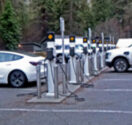
(See further down at this webpage for directions from this intersection to Upper Pines campground for our trip.)
– – – – – – – – – – – – – – – – – – – – – – – – – – – – – –
OR, if you are not going to Curry Village or the Upper Pines Campground, get in the left lane and turn left to go to Yosemite Village Day Use parking (which is a short walk to the main Visitor Center, biggest grocery, museum, Post Office, various restaurants) and to the garage, Medical Clinic, and the Ahwahnee hotel, or back out of the park.
People going to the Yosemite Lodge, Yosemite Falls free parking lot, and Camp 4 (Camp Four) who failed to turn at Sentinel bridge should also turn left.
This road eventually bears left, goes past one side of the Ahwahnee meadow, and brings you to the round about that is no longer used as a circular road as you might be used to.
The first set of signs (photo below) tells you:
Left Lane
Curry Village
Yosemite Valley Lodge
Right Lane
The Ahwahnee
Clinic
Yosemite Village

You should anticipate which lane you want to be in, and also anticipate that many people will not realize which lane they should be in and may change lanes suddenly or even come to a full stop in the roadway.
Past these signs, before the round-about, there are signs warning of a pedestrian crosswalk,
15 mile per hour speed limit signs, and another sign tells you that the Left Lane Must Turn Left (and go around one side of the former round-about)
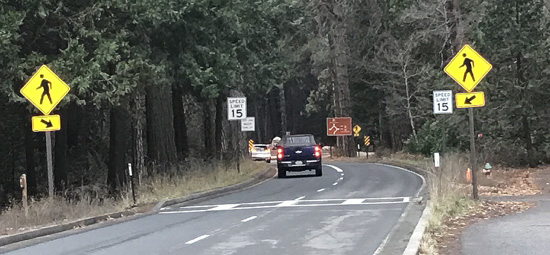
If you want to go to the Yosemite Lodge, Camp 4 (Camp Four), Yosemite Falls free day use parking or back out of the park, you circle around the round about from either lane and continue on Northside Drive.
Northside Drive runs almost the length of Yosemite Valley as a one-way road, from east to west, as outlined in red on the map below:
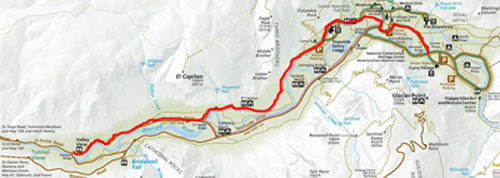
OR if you want to go the store, garage, medical clinic or the Ahwahnee hotel you briefly enter the round-about and turn right, as shown in this sign showing the right lane route:
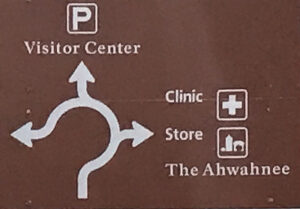
If you briefly enter the round-about and turn right, you then drive past the garage and more on your right / the backside parking lot of the main grocery store (which has pubic restrooms and handicapped parking) on your left and make a right at the stop sign.
The next road section, Ahwahnee Drive, takes you past the Medical Clinic on your left, then past the Ahwahnee meadow on your right, Church Bowl on your left (a small picnic area with restrooms).
As you pass Church Bowl your view ahead of Half Dome is blocked by 114 Ponderosa and 117 Cedar trees which will be removed to restore the view.
This next photo is from the Merced River Plan (look for page H-27), which says about the tree removal work. . .”large trees help buffer the impact, and potential damage, of rockfall by absorbing some of the force and rock debris. Most of the trees currently obscuring the view are outside of the rock fall zone, on the south side of the road and not effective in protecting any structure. No trees on the north side of the road within the rockfall hazard zone will be removed.”
When a helicopter needs to land in the Ahwahnee meadow (in the right hand side of the photo above), across the road from Church Bowl, to pick up someone who needs to go to a bigger hospital, (or when a helicopter needs to land for Search and Rescue training) people are asked to stay on the restroom/picnic area side of the road, and traffic going through is briefly stopped.
Because you won’t know a helicopter is coming and won’t be able to move your vehicle fast enough, the entire meadow side of the road at Church Bowl is closed to any parking at all times,
(even to get out and quickly take a picture or use the restroom).
In this photo you can see a few parking spaces in a row alongside the restroom/picnic area side of the road and the commonly ignored stripes for no parking with big letters on the pavement that say NO PARKING, on the other side of the road:
Just past Church Bowl on the left of the road is this stone entrance gate:
SEE driving directions to the Ahwahnee Hotel for more on this route if you want to go to the Ahwahnee hotel.
IF YOU ARE GOING TO UPPER PINES CAMPGROUND or CURRY VILLAGE
When you are at the intersection where Southside Drive comes to Northside Drive at Curry Village

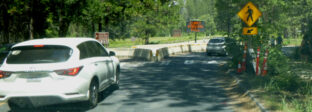
Be in the right hand lane and turn right and bear left to go to Curry Village checkin & services and/or to go through Curry Village to the Campground.
In the photo below, the red X shows where Southside Drive previously went through to the Pines campgrounds.
The two-way road to the campgrounds is still there, but you need to drive through Curry Village and alongside the left of the Curry parking lot (the parking lot is in the lower right corner of the photo below) to get to it. (See more about this further down on this webpage.) On some maps the road changes name to Happy Isles Loop Road, which is the long strip of road between the two meadows in almost the center of the photo below.

Within Curry Village, Curry Village Drive is mostly two way.

Below is a NPS map of services, restaurants, and the Front Office where you go to check in for your reservation at Curry Village:
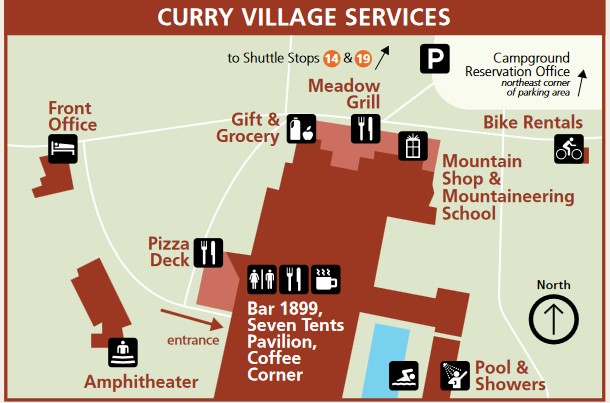
Here is your route around the parking lot towards the campground:
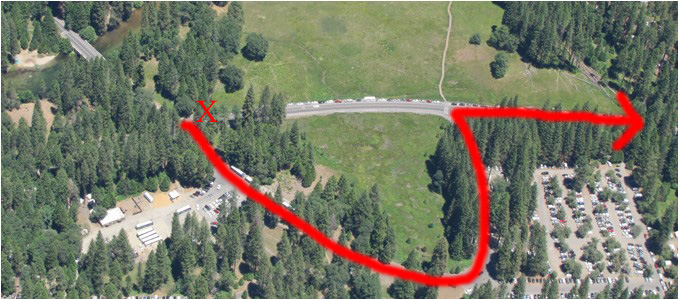
and another map with the route in blue:
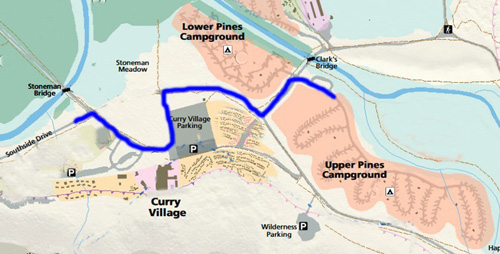
The section of Southside drive (Happy Isles Loop Road) the blue line goes to the Pines Campgrounds, and the road also can get you to the Wilderness Parking lot (trailhead parking for those with a wilderness permit), and a shuttle bus road around to Happy Isles/trailhead for Vernal mist trail and Nevada falls, a trailhead for Mirror Lake, and the stables. Find locations and details about each of these places at the Yosemite free shuttle bus page.
– – – – – – – – – – – – – – – – – – – – – – – – – – – – – – – – – – – – – – – – – –
To go to Upper Pines Campground (the only Pines campground open in the winter during our trip) you will go along the edge of the Curry Village parking lots, and follow signs to turn right at a “T” intersection.
and you will be on the road to the Pines campgrounds, another two-way road.
When Yosemite roads are plowed to remove snow, they are not always fully cleared, and people can decide to try to park at the side of the road to get pictures, even though they block part of a driving lane. If you allow yourself to be distracted by Half Dome peeking from clouds you could have trouble.
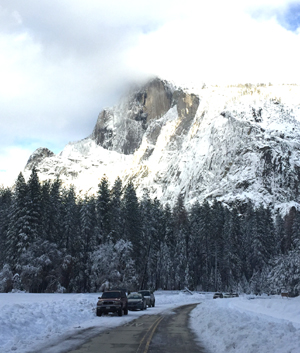
The road goes past a big meadow on the left, bears right, then curves left (at that curve do not take the shuttle bus access road that goes off to the right/straight-ish).
and in the summer that road, may have signs closing it.
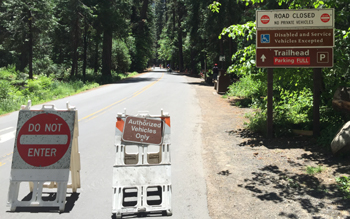
or instead of a sign saying “trailhead parking full”,
a sign telling you that the small parking lot ahead is reserved for people with wilderness permits:
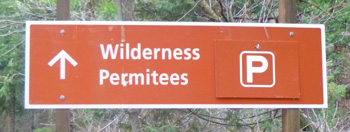
After going left, on your right, there will be two driveways out and into the RV camper dump station before you get to the campground entrance:

Just before a bridge, make a right into Upper Pines Campground.
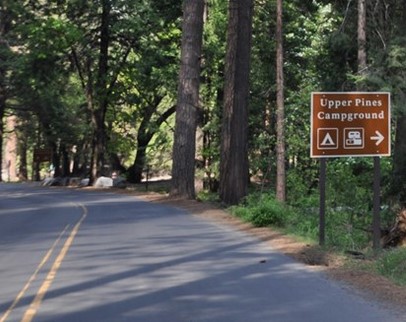
If it has been snowing a lot the entrance to the campground can be a little hard to spot in the big snow banks and the road in sometimes becomes so narrow it is really only a one lane road. The park service does not always snow plow the campground road/loops as often as the main roads.

Upper Pines Campground usually only has the first two loops of campsites open in the winter:
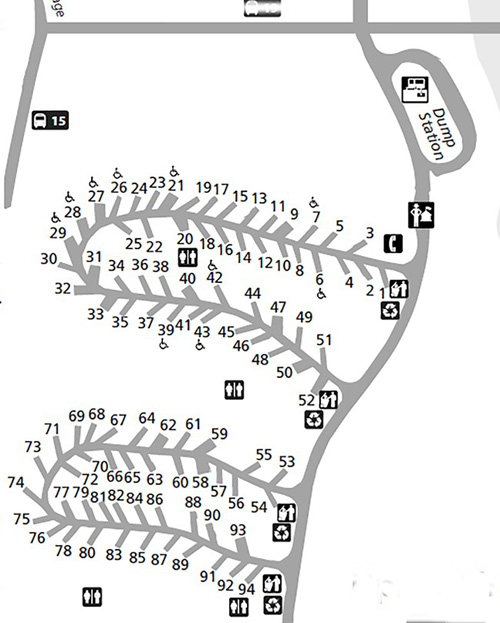
Please turn off the stereo before you enter the campground
so as to not disturb people in neighboring campsites.
If you got a reservation for a campsite, or are sharing one that someone else made, you are set up BUT a storm could suddenly cause some of the campsites to not be usable, so . . . have a credit card available for alternate overnight accommodations. OR be prepared to move to whereever the Rangers reassign campers to.
Below a photo of the bulletin board (where you can put a message to people sharing a site with you, for example) on the right just past the campground entrance kiosk (see just beyond the stop sign in this photo, the dark brown bulletin board is much bigger than it looks in this photo):
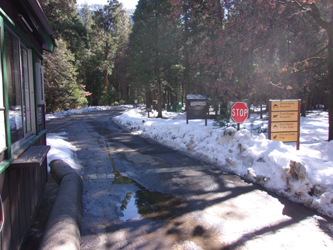
and the bulletin board is on the far right hand side of this photo:
Big Hint: The Ranger at the kiosk on the left in the photo above, just before the campground loops, would really like you to come to a full stop at the stop sign next to the entrance kiosk.
People on our trips plan in advance, who will occupy each of the campsites people get reservations for. This is often finalized at the pre-trip meeting-and-last-chance-to-sign-up.
At some sites it is easy to fit the two cars (trucks, SUVs) people often drive. (Upper Pines campsite parking spaces are mostly 24 to 35 feet long (a few only 18 feet), many can’t fit vehicles side by side.) If we get lots of snow it can be a tight fit because of the piles of snow in campsite parking spaces NOT YET removed by the snowplows, OR a snow shovel could be wise to bring because when they plow, the snow plows do not clear the campsite parking spaces at all completely. If you are the first one there, and expected to share a site, pull all the way forward and all the way to one side so the next vehicle can fit in next to you. (Your vehicles must be totally off the road and on the campsite parking pad.) Puuuuleeeeease don’t wait to park properly until the other vehicle sharing the campsite parking space arrives and make them go looking for you. If you don’t fit side by side and end up parking behind another vehicle and blocking them from leaving, please plan to talk to them before you leave the campsite to go for a night hike, go ice skating, etc.
Yes, the photo below was just one night of snow.
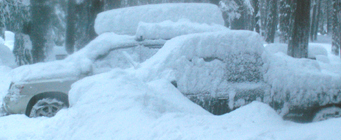
Wise winter travelers lift their wiper blades up off their windows so they are not frozen in place in the morning:
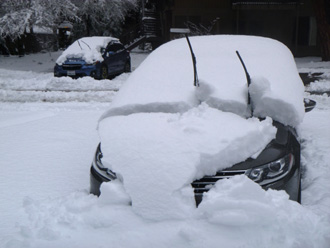
After the kiosk/bulletin board, the first road coming towards you from the right is the start of the first campground loop, a one-way road. The next road coming towards you from the right is the end of that first campground loop.
The third road coming towards you from the right is the start of the second campground loop, again one way.
A complete campground map is at:
https://www.nps.gov/yose/planyourvisit/upload/pinescombined.pdf
Sometimes the seasonal temporary creek totally floods some campsites, and they or or whole loops are closed accordingly:
Please note that you need to be sure you only have 6 people sleeping in each site.
If there are people around in other sites for our group who are all unpacked and have eaten dinner they will probably help you set up your tent, just like you’ll do for the next car …. yes?
_____________________________________
You won’t have to drive much more during the trip if you use the Yosemite Valley free shuttle bus and the free bus to (Badger Pass) Yosemite Ski & Snowboard Area.
__________________________________________
There is little parking in Yosemite valley beyond your campsite, hotel area or day use parking. If you park off the side of the road, not in a parking space, (as in the photo below, off road behind a large rock meant to deter anyone from parking there) you can get a parking ticket with a $200 + fine (orange ticket under the windshield wiper) in this photo:
__________________________________________
![]()
Top reasons to not speed in a National Park has defensive driving advice.
__________________________________________
Prepare for winter driving has a link to bad weather driving tips, tips for using tire chains, tricks for dealing with frozen car locks, how to prepare your vehicle for winter driving, a winter survival kit for your car and what to do if you get stranded.
It includes this advice:
My windows are fogging up faster than my navigator can wipe it off!
Yes, it’s cold out and you filled your car with people to share the trip expenses. They all are exhaling foggy breath, especially when you all sing along to that CD. Have them take turns holding their breath. Okay, maybe that’s not practical. Have them pay up for the gas expense in advance and let them off at the next bus stop. Unthinkable? The swimmers in the Outdoor Club know they can lick the inside of their swim goggles to prevent fogging, but a windshield…?
Not really practical either. . . well then . . .
The fog on the windows could be caused by trying to keep the car interior warm. When air is warm breath condenses, so stop and have your passengers put on those longjohns, jackets and maybe even knit hats, then keep the car cool. Even a few degrees will affect the maximum amount of water in the air quite significantly. With less water in the air the windows will frost up less.
Make sure your air conditioner or heater is in the fresh air position rather than recirc. The recirculate setting reuses the humid air already in the car. The air in the car is quite humid due to those mammals you are giving a ride to, and the outside air is less humid (even if it’s raining/snowing), so pull it in and push it against the inside of the window. And even though you are trying to keep the air in the main compartment coolish, the windows themselves need to be warmer than the cold air/rain/snow hitting them, so set the temperature to warm. Pulling in outside air has the drawback of sucking in truck or diesel exhaust, so pull back from that big rig or go around it. Set the fan to its highest setting if you are going in slow traffic.
Now you can go back to your sing-along or heavy gossip session.
It uses less gas to drive with the air conditioning on than to drive with windows open.
Some people recommend wiping your windshield interior with shaving cream to de-fog it, but we do not because it can smell minty to the bears and they break into vehicles they can smell “food” inside of.
See also: services (minor emergency repairs, towing for some vehicles), available at the Yosemite Village garage. At that page you will find a list of a list of locations of Electric Vehicle (EV) charging stations at the various hotels, near campgrounds, the Welcome Center and more.
You might also want to read How to not collide with a deer,
Safe driving in rain and fog,
Prepare for winter driving,
wildlife jams, and/or
Snow chain rentals .
Road trip advice and etiquette has ideas for limiting boredom, getting along on a road trip and some packing and safety tips.
______________________________
On your way out of Yosemite valley:
Exiting Yosemite valley on northside drive, (top of the map below) there are two stops many people take to see El Capitan.
Just past El Capitan crossover, on a section of usually one-way Northside Drive (where the road goes across the Merced River on the map above), there is usually lots of parking along El Capitan meadow on the left.
And this view of El Capitan:
Valley View (seen on the way out of Yosemite Valley, the small parking lot is on the left hand side of one-way Northside Drive)
panorama spring and winter:
first two photos below by Quang-Tuan Luong/terragalleria.com, all rights reserved.
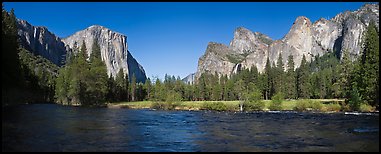
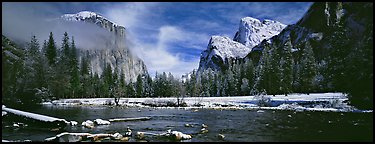
and here, a close-up of Bridalveil Fall:
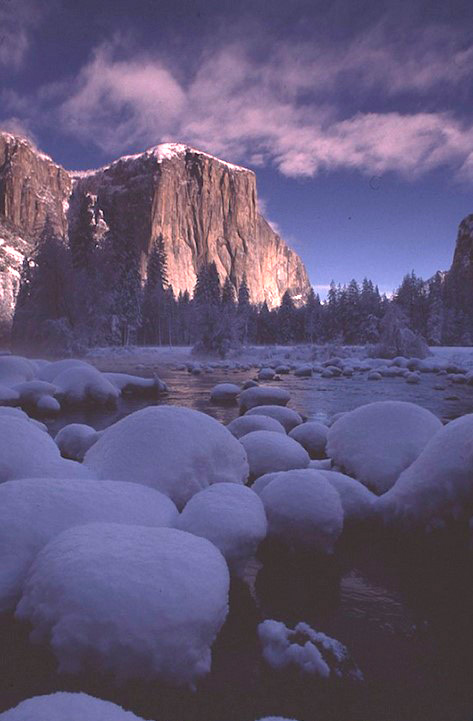
If you are lucky you might see a Dipper swimming in and out of the ripples very near you, any time of year, including this photo taken in December:

______________________________
Yosemite driving / hiking distances
Yosemite driving distances
junction Big Oak Flat road and El Portal Road
– Junction Northside and Southside drives .9 mile
-Junction Northside and Southside drives – junction El Cap crossover 1.4 miles
(Southside drive) junction El Cap crossover – junction at Sentinel bridge 2.7 miles
junction at Sentinel bridge to junction at Curry Village 1 mile
Yosemite Village – junction El Cap crossover 3.2 miles
Bridal Veil fall parking to far end of Wawona tunnel 1.6 miles
junction of Southside drive at Curry Village to start of Happy Isles road .4 miles
start of Happy Isles road to Mirror Meadow bus stop 1.2 miles
Mirror Meadow bus stop to junction at start of Happy Isles road .4 miles
junction of Southside drive at Curry Village (briefly named Half Dome Village) to main day use parking .8 miles
Yosemite Village to Tioga pass road 18 miles
Tioga pass road to Tioga pass entrance station 47 miles
Tioga pass entrance station to Lee Vining 13 miles
junction Tioga pass road to Big Oak Flat entrance station 9 miles
Big Oak Flat entrance station to Hetch Hetchy 18 miles
Yosemite Village to Chinquapin Junction 14 miles
Chinquapin Junction to Glacier Point 16 miles
Chinquapin Junction to south entrance station 17 miles
Yosemite Village to Arch Rock entrance station 11 miles
Arch Rock entrance station to Mariposa 34 miles
hiking distances for most Yosemite National Park trails can be found at:
https://www.nps.gov/yose/planyourvisit/upload/trailheads.pdf
Bridal Veil fall parking to Bridalveil fall .5 mile (.8 kilometers) round trip
lower Yosemite fall round trip from bus stop 1 mile (1.6 kilometers)
Mirror Lake round trip from bus stop 2 miles (3.22 kilometers) round trip
from Happy Isles bus stop to:
– Vernal Fall footbridge 1.4 miles (2.25 kilometers) round trip, 400 foot (122 meters) elevation gain
– top of Vernal Fall 3 miles (4.83 kilometers) round trip 1,000 foot (304 meters) elevation gain
– top of Nevada Fall 5 miles (8.05 kilometers) round trip 1,900 foot (579 meters) gain
Four mile trial to Glacier Point 4.8 miles one way, 3,200 feet (975 meters) elevation gain
Camp 4 to Columbia Rock 2 mile (3.21 kilometers) round trip, 1,000 feet (304 meters) gain
Camp 4 to top of Yosemite falls 7.2 miles (11.59 kilometers) round trip, 2,700 foot (823 meters) elevation gain
You have a number of lodging choices of where to stay overnight in Yosemite Valley in Yosemite National Park, including campsites or
wood-walled cabin without a bath; heated or unheated wood floored, canvas sided and roofed tent cabin; wood walled cabin with a bath
luxury or generic hotel rooms, suites with a bath
__________________________________________
You can find basic to extravagant, (a few with a dress code),
casual, fast (grab and go)
or with table-side service,
indoor and outdoor food service
at multiple locations in Yosemite Valley, as well as four grocery stores
all of which are served by the Yosemite valley free shuttle bus.
Some history of previous road closures in the vicinity of Yosemite:
A rockslide closed 120 for a day and then for about six weeks for repairs in 2012. In winter 2017, highway 120 was closed for weeks. A March 2 news release said: “Significant rain and snow this winter has saturated the soils, resulting in movement under the road bed. This soil movement has caused a large fissure to form in the roadway that has resulted in both lanes of traffic being unsafe for vehicles. Soils under the road continue to move, causing further damage. Over 100 feet of road, near the Big Meadow Overlook, has been impacted by this fissure. There is no estimated date for the road to reopen.”

A rock slide on Highway 140 west of El Portal closed the road for months in 2006 and when it was reopened, there was a vehicle size limit. One day a driver of an oversized vehicle ignored the size restrictions, got stuck and closed the road to everyone for hours. A 15 foot X 6 foot X 4 foot boulder closed it briefly in December 2010. Nov. 1, 2016 several large boulders fell and and landed on 140 within the park, completely closing that section of the road for a day/night.
June 12, 2017, 140 was “closed from the Big Oak Flat Road intersection to Park-Line for at least 24-hours due to a significant rock-slide near Dog Rock.” Then the closure time was lengthening to many days. The location of this slide caused a 2 1/2 – 3 hour drive from Yosemite valley to hotels just outside the park entrance instead of the usual half hour.
November 16, 2017, highway 140 was closed for about 20 hours after a big rain storm “due to small debris flows.”
Just one huge rock could close it again at any time.
You can see a photo of the planned rock shed at a Cal Trans page:
https://dot.ca.gov/-/media/dot-media/district-10/documents/f0005624-factsheet.pdf
Where it says: “Project Description: Permanently restore full highway access on State Route 140 between the communities of El Portal and Mariposa by removing loose debris (talus) caused by the 2006 Ferguson Rockslide. Crews will also construct a 2 -lane structure on the original alignment. The $133 million project has been split into two phases. Phase 1 will remove the existing talus material and install cable net drapery to minimize additional rock fall. Phase 2 will construct a 750-foot structure on the same alignment. . . . Project site will be inactive until the rockshed design is completed and contracting process for Phase 2 is completed. Construction of the rock shed was originally anticipated to begin in March 2016, if weather permitted; however, during the winter suspension of the project there was rock fall and a significant rockslide in November 2015. The Caltrans Office of Geotechnical Services assessed area and the project team decided more assessment was needed to determine the stability of the slope. . . ”
and in March 2021:
“Caltrans To Resume Work On Ferguson Project
The California Department of Transportation (Caltrans) is preparing to continue work at the site of the Ferguson Rock Shed project on State Route 140 in Mariposa County. In the first phase of the construction project, workers will remove overhanging boulders and rubble from the slope where a rockslide blocked the roadway. Crews are scheduled to conduct this work during daytime hours beginning in April and continuing into the winter season of 2021. Traffic impacts are expected to be minimal. The Ferguson Rock Shed Project will ensure motorists have safe access to Yosemite National Park via Route 140. Construction of the rock shed is scheduled to begin the summer of 2022. This work is scheduled is subject to change due to traffic incidents, weather, availability of equipment, and/or materials and construction related issues.”
Visitors are always urged to use caution when driving through any rockfall area. Some sections of road are completely closed to parking/stopping, even to briefly take a photo. Watch for signage.
A fall/winter message from the Park Service to employees said:
“Greater Likelihood Of Rock Debris On Park Roads During Wet Weather
With wet winter weather just around the corner, drivers are reminded of the greater likelihood of encountering rock debris on park roads during wet weather. Although rockfalls are always possible along all park roadways, they tend to happen more often during winter storms. The area affected by the June 12, 2017 rockfall at Parkline Slab (downhill of Dog Rock) may be particularly prone to storm-triggered rockfalls, as there is abundant loose debris on the bedrock slope above the road that is likely to be mobilized by significant rainfall.
Those driving the El Portal Road should be especially vigilant for rock debris below Parkline Slab during or immediately after rainstorms, and be aware that road closures may occur in response to these storms.
If you encounter small rock debris on the road, drive through the area (do not stop within the debris) and promptly report it to Park Dispatch. Do not attempt to remove the debris yourself – leave that task to road crews equipped to do so safely. If you encounter large rock debris on the road, turn around and promptly report it to Park Dispatch.”
Again, CALL the road info number before you leave town, and perhaps again during your drive!
There were probably people who did not call in early April 2018 and they did not know Yosemite Valley was closed to visitors, reservations for campsite and hotel rooms were cancelled.
Messages April 5, 6, 7: “Due to anticipated flooding, Yosemite Valley is closed. We will evaluate conditions on Sunday morning and open as soon as it is safe. All other areas of the park are open, conditions permitting. Call 209/372-0200 (then 1, 1) to check road conditions.” . . . “River expected to peak at 5PM (14.7 ft). Residents stay inside. Southside Dr. 2-way traffic for emergencies. Caution: tree failures.”
Message April 8, 2018: “Yosemite Valley will open to all vehicles and visitors at 12:00 noon today. Yosemite Valley has been closed to the public since Friday due to anticipated impacts to roads and infrastructure from high water. Water levels in the Merced River crested at 13.73 feet at Pohono Bridge, which is approximately 4 feet over flood stage. Park roads were 2 to 4 feet underwater Saturday afternoon through late Saturday night.”
– – – – – – – – – – – – – – – – – – – – – – – – – – – – – – – – – – –
